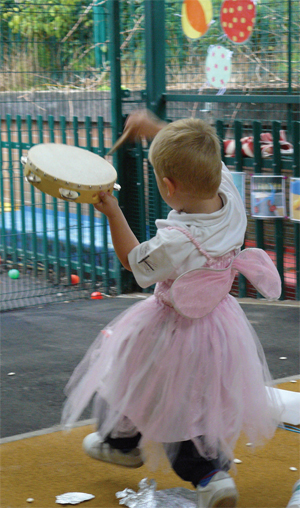Ruth Churchill Dower highlights the strengths and weaknesses of current early years policy and provision.

In England, Scotland and other European countries, Ministries of Education, Culture and Health have begun to recognise the importance of creative approaches to the development of very young children. They have started to support this with responsible policies, cross-agency partnerships, and child-oriented learning frameworks. Policy and practice have a dynamic influence on each other. At the same time, our arts and cultural policies (and practices) are being repositioned to engage and meet the needs of children and young people. Creative approaches to teaching, learning, thinking and playing have been widely recognised as valuable for a better quality of life for children and their families, and to build a set of attributes and skills that offer the best possible start in life.
Forming connections
Against the backdrop of Every Child Matters, and, more recently, the Children’s Plan, coupled with the implementation of the Early Years Foundation Stage learning framework, Earlyarts conducted a programme of research in partnership with the Paul Hamlyn Foundation. The research explored: where the intersection lies between creative practice and early years; what the map of current provision looks like across England; the influence of funding and policy priorities; how much is underpinned by pedagogical or theoretical approaches; what potential exists for more effective partnerships; aspirations for, and constraints on, capacity to meet young children’s creative learning needs. Almost 300 professionals responded, strengthening the call for a learning network of artists, organisations and agencies across the UK. Many demonstrated an absolute belief in the potential of creative approaches and are promoting these as the bedrock of their early learning frameworks. To understand why, it’s worth taking a look at some of the facts. A baby’s brain is not fully developed when it is born, but has a much higher growth rate than at any other time in its life. Babies form trillions of synaptic connectors (pathways in the brain through which knowledge and understanding are formed and contextualised, and which hold the key to each individual child’s personality). These are halved by early adolescence, as the brain constantly prunes those which are under-used or ignored, leaving room for stronger growth of other synapses. This is why creative experiences are so important during the earliest stages, so that the synapses that are predisposed towards creative skills might survive the pruning.
Early blossoming
It is thought that child-oriented creative play-based activities have a direct relationship with helping synaptic connectivity to bloom. This leads to the formation of well-rounded personalities, good attachment, self esteem and better mental health. In order to recognise and support the complexity of children and young people’s identities, we need to investigate, listen, understand, respect and celebrate who children are now – not just prepare them for the future. This helps them find a sense of place, recognise their cultures amongst many communities, develop self-assurance, confidence and a feeling of belonging, and understand that they have a place in global society. This is already the basis of much creative early years activity across England, which is a positive picture. There are organisations whose respect for children underlies their whole culture, and their practice is exploratory, exciting and hugely developmental. Earlyarts’ research gathered the top ten characteristics of success:
1. Integrated partnerships between families and outside practitioners are much more successful in jointly meeting, and continuing to support, a child’s needs.
2. Passionate advocates in arts, culture and early years settings who understand the potential of playful learning environments are effecting a change across the country.
3. Reggio Emilia, a cultural approach to learning with 0–6s, is the most influential pedagogical approach to creative early years work according to respondents, closely followed by the Forest Schools network, which offers an educational approach to outdoor play and learning, and experiential or enquiry-based approaches.
4. Early years professionals and artists or creative professionals are gaining a depth of professional development from working together that is not available from traditional training programmes, and that is having a direct impact on improving practice.
5. Open-ended enquiry-based (rather than assessment-based) approaches nurture essential learning dispositions, including curiosity; imagination; exploration; negotiation; confidence; risk-taking; self-esteem; enjoyment; engagement; and sustained thinking, which help the transition through school.
6. The contribution of creative approaches to early learning could be demonstrated through evidence-based research, which makes clear links between research, pedagogy and policy to improve practice.
7. Statutory initiatives significantly influence arts, culture and early years services’ activities. There is scope within the most influential initiatives to advocate for the involvement of creative practice in daily contact and engagement with very young children.
8. Approaches which achieve deeper learning and engagement require longer-term resourcing. This is rarely available within the existing funding structures which favour short-term, single sector project funding. This risks the loss of valuable experience, knowledge and research.
9. Workforce development can lead to broader aspirations and a reflective learning culture. This is enhanced by collaboration with creative practitioners in the training for early years professionals, PGCEs, NVQs and foundation degrees.
10. The sector has identified a need for: innovative approaches to creative practice; a forum for shared reflection and dialogue; tools for planning partnerships; brokership with artists; an evidence base of research to call upon as a basis to develop practice; high level advocacy; professional skills development and information dissemination; and a national network of joined up thinking.
A national network could bring partners together to bring clarity, evidence and guidance to the sector. It is a crucial opportunity for practitioners and policy makers to draw together to plan, implement, learn, and change practice on a large a scale. Next step – do it!
Ruth Churchill Dower is Director of social enterprise Isaacs UK, which runs Earlyarts, a professional development network supporting over 3,400 arts, cultural and early years professionals working creatively with young children and families. It recognises the rights of children to access playful learning environments as part of their development, and helps foster the environments, resources, skills and knowledge that can meet children’s needs effectively.
e: ruth@isaacsuk.co.uk
w: http://www.earlyarts.co.uk; http://www.isaacsuk.co.uk




